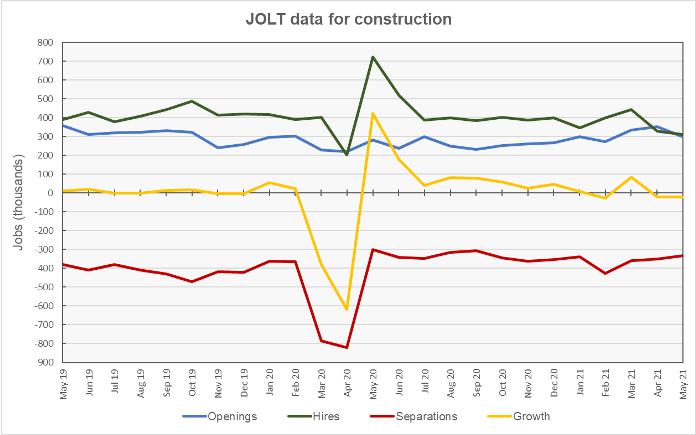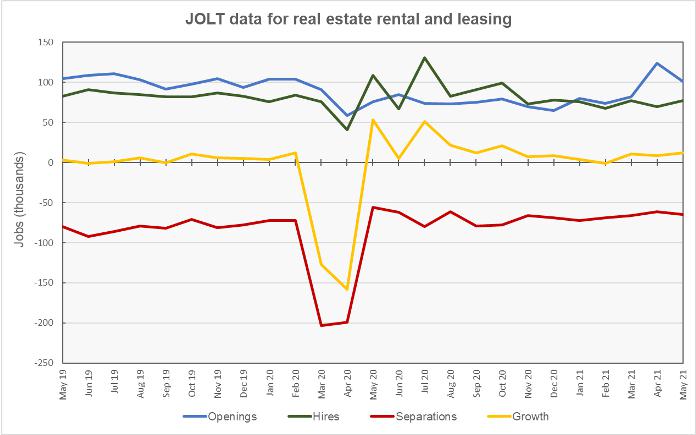The Bureau of Labor Statistics (BLS) recently released the Job Openings and Labor Turnover (JOLT) report for May. Although last month’s report set a series record for the highest number of job opening, job openings were up fractionally again this month. However, construction job and real estate job openings were lower for the month.
Measuring the jobs market
For a discussion of the JOLT report and how it relates to the Employment Situation Report, please see the paragraph at the end of this article.
The BLS reported that there were 9.2 million job openings at the end of May. This represents 6 percent of the total employment plus job openings. Within the nonfarm labor market, the number of people quitting their jobs declined almost 10 percent to 3.6 million, while the percentage of people who were involuntarily separated from their jobs hit a series low of 0.9 percent. The number of people hired for a new job in May was 5.9 million.
Construction jobs down
The first chart, below, shows the employment situation for the construction jobs market over the last 25 months. After a string of months with employment gains between May 2020 and January 2021, the construction jobs market has suffered a net loss in employment in 3 of the last 4 months. While February’s job losses can be attributed to a rise in separations, separations have fallen for the last two months. However, the pace of hiring has fallen even faster.

Revisions to April’s hires and separations numbers raised the job losses for that month from the preliminary level of 12,000 reported last month to a loss of 21,000 construction jobs for April in the latest report. The preliminary construction job losses for May came in at 22,000.
Openings for construction jobs fell 15 percent in May to 299,000 jobs. This is despite April’s figure being revised downward by 6,000 job openings. Hiring was down modestly in May, falling 5 percent to 311,000 jobs.
Separations fell by 5 percent in May. Layoffs were nearly unchanged while quits fell by 9 percent. “Other separations” which includes retirements and transfers, were up by 20 percent, but they represent a small portion of all separations. Quits represented 53 percent of separations for the month.
RERL jobs growth stays positive
The last chart, below, shows the employment situation for the real estate and rental and leasing (RERL) jobs category. Employment growth in this jobs category was again positive in May as a rise in hiring overcame an increase in separations.

The number of job openings in the RERL category fell in May to 101,000. This was a drop of 23,000 job openings despite net employment growth of only 12,000 jobs for the month.
Hires in May were up by 10 percent to 77,000 while separations rose 7 percent to 61,000. The percentage changes are based on the revised figures reported for April. Quits again represented 70 percent of total separations in May, indicating that employees have plenty of job options to choose from.
The numbers given in the JOLT report are seasonally adjusted and are subject to revision. It is common for small adjustments to be made in subsequent reports, particularly to the data for the most recent month. The full current JOLT report can be found here.
The reports
The US labor market is very dynamic with many people changing jobs in any given month. The JOLT report documents this dynamism by providing details about job openings, hiring and separations. However, it does not break down the jobs market into as fine categories as does the Employment Situation Report, which provides data on total employment and unemployment. For example, while the Employment Situation Report separates residential construction from other construction, the JOLT report does not. The Employment Situation Report separates residential property managers from other types of real estate and rental and leasing professionals, but the JOLT report does not. However, the JOLT report provides a look at what is driving the employment gains (or losses) in broad employment categories.















